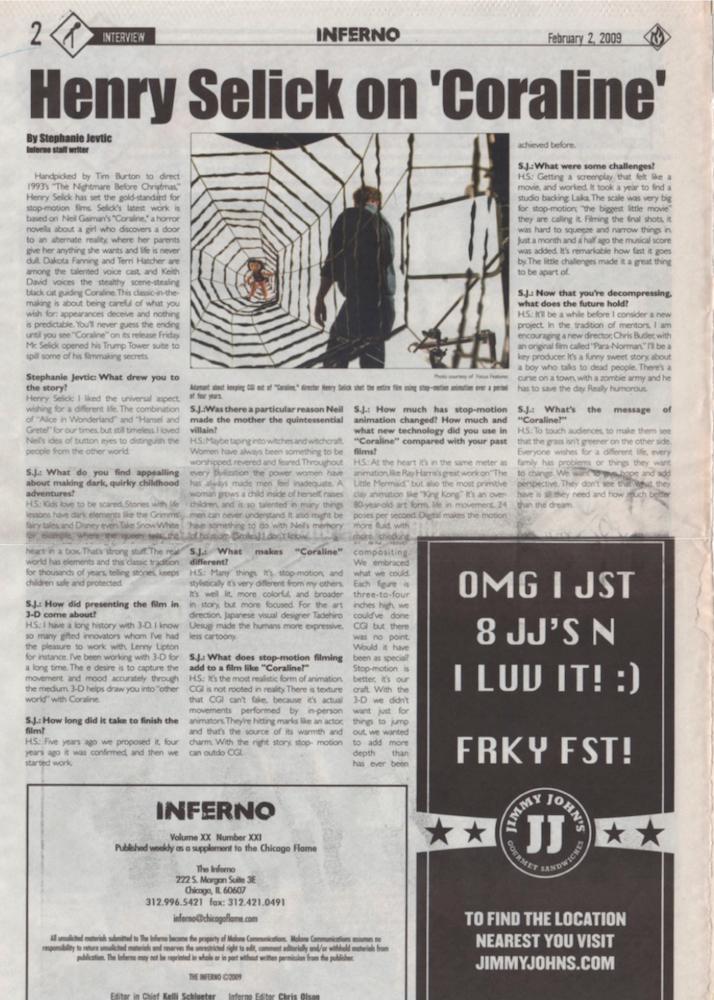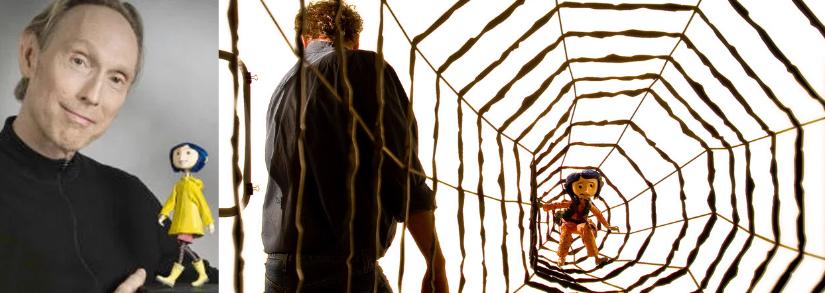Henry Selick “Coraline” Interview
For you parents out there with young children who are discovering one of the Halloween perfect movies Coraline, who’d like some answers. My interview with Henry Selick.
What inspired me to bring this thing out of the Stephanie vaults was because our daughter saw Coraline at the library a couple days ago, and asked for us to check it out (with her library card of course). Now it’s her HER Halloween movie of the moment. Wait till she finds out mommy got to meet & interview the man behind it ☺️: Henry Selick.
As a parent I re-read the article soo diferently, which is why I want to share this interview—I really think it is a great help for how to explain the moral of the story (and more) to a child. Coraline is among many children’s and adult’s favorite Halloween movies, and since I had an unique opportunity to get some answers straight from the man behind it, HIMSELF, I thought why not share it with my parent readers?

Sitting with the Master of Stop Motion, about “Coraline”
Handpicked by Tim Burton to direct 1993’s “The Nightmare Before Christmas,” the new generation of youngsters will have “Coraline” as their first stop-motion animated film by the prince of the art form, Henry Sellick. The film is based on the Neil Gaiman children’s horror novella about a girl who discovers a door to an alternate reality, where her parents give her anything she wants and life is never dull. Dakota Fanning and Terri Hatcher are among the talented voice cast, and Keith David is the stealthy scene-stealing black cat guiding Coraline. This classic in the making is about being careful of what you wish for and it’s in 3-D! It was heart pumping, appearances deceive and nothing is predictability. You’ll never guess the ending until you see “Coraline” on its release February 6th.
Mr. Selick opened a portal to his Trump Tower suite, to spill some filmmaking secrets.
Stephanie Jevtic: What drew you to the story?
Henry Selick: I liked the universal aspect, wishing for a different life. The combination of “Alice in Wonderland” and “Hansel & Gretel” for our times, but still timeless. I loved Neil’s idea of button eyes to distinguish the people from the other world.
S.J.: What appeals to you to make these great dark quirky childhood adventures?
H.S.: Kids love to be scared. Stories with life lessons have dark elements like the Grimms’ fairy tales and Disney even. Take Snow White for example, where the queen tells the hunter to kill and bring back Snow White’s heart in a box. That’s strong stuff. The real world has elements and this classic tradition for thousands of years, telling stories, keeps children safe and protected.
S.J.: How was presenting the film in 3-D come about?
H.S.: I have a long history with 3-D. I know so many gifted innovators whom I’ve had the pleasure to work with, Lenny Lipton for instance. I’ve been working with 3-D for a long time. The ultimate desire is to capture the movement and mood accurately through the medium. 3-D helps draw you into “other world” with Coraline.
S.J.: How long did it take to make?
H.S.: 5 years ago we proposed it, 4 years ago it was confirmed, and then we started work.
S.J.: Was there a particular reason Neil made the mother the quintessential villain?
H.S.: Maybe taping into witches and witchcraft. Women have always been something to be worshipped, revered and feared. Throughout every civilization the power women have has always made men feel inadequate. A woman grows a child inside of herself, raises children, and is so talent in many things men can never understand. It also might be have something to do with Neil’s memory of his mom. {Smiles} I don’t know.
S.J.: What makes “Coraline” different?
H.S.: Many things. It’s stop motion, and stylistically it’s very different from my others. It’s well lit, more colorful, and broader in story but more focused. For the art direction, Japanese visual designer Tadehiro Uesugi made the humans more expressive, less cartoony.
“We want to give hope and add perspective. They don’t see that what they have is all they need and how much better than the dream.”
Henry Selick on the message of Coraline
S.J.: What can stop motion add?
H.S.: It’s the most realistic form of animation. CGI is not rooted in reality. There is texture that CGI can’t fake, because it’s actual movements performed by in person animators. They’re hitting marks like an actor and that’s the source of its warmth and charm. With the right story slow motion can outdo CGI.
S.J.: How much has stop-motion animation changed? How much and what new technology did you use in “Coraline” compared with your past films?
H.S.: At the heart it’s in the same meter as animation, like Ray Harris’s great work on “The Little Mermaid,” but also the most primitive clay animation like “King Kong.” It’s an over 80 year old art form, life in movement. 24 poses per second. Digital makes the motion more fluid, with more checking in and faster compositing. We embraced what we could. Each figure is 3×4 inches high, we could’ve done CGI but there was no point. Would it have been as special? Stop motion is better, it’s our craft. With the 3-D we didn’t want just for things to jump out, we wanted to add more depth than has ever been achieved before.
S.J.: Should parents know something before their kids see it?
H.S.: The film has a PG rating, so children 8 or younger shouldn’t go. It’s not for young kids, it’s too scary for them. It’s for brave children of all ages, as the studio likes to put it. What we’ve found is that parents are the scaredy cats, so the kids have to explain things to them. {Smiles}
S.J.: What were some challenges?
H.S.: Getting a screenplay that felt like a movie, and worked. It took a year to find a studio backing: “Laika.” The scale was very big for stop motion, “the biggest little movie” they are calling it. Filming the final shots, it was hard to squeeze and narrow things in. Just a month and a half ago the musical score was added. It’s remarkable how fast it goes by. The little challenges made it a great thing to be apart of.
S.J.: Now that you’re decompressing, what does the future hold?
H.S.: It’ll be a while before I consider a new project. In the tradition of mentors, I am encouraging a new director, Chris Butler, with an original film called “Para-Norman” I’ll be a key producer. It’s a funny sweet story, about a boy who talks to dead people. There’s a curse on a town, with a zombie army and he has to save the day. Really humorous.
S.J.: What’s the message of the film?
H.S.: To touch audiences, to make them see that the grass isn’t greener on the other side. Everyone wishes for a different life, every family has problems or things they want to change. We want to give hope and add perspective. They don’t see that what they have is all they need and how much better than the dream.
This article appeared in the Chicago Flame Newspaper on February 2, 2009. Written by me (then Stephanie Jevtić) while I was a student at the University of Illinois at Chicago (UIC).


1 comments